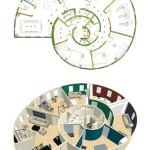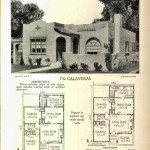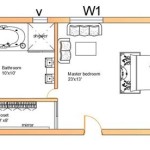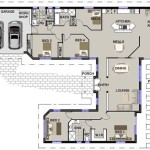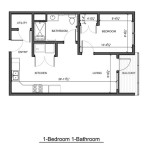Small House Floor Plans With Wrap Around Porch: Optimizing Space and Outdoor Living
The allure of a small house lies in its inherent efficiency, affordability, and reduced environmental footprint. When coupled with a wrap-around porch, a small house transforms into a haven that seamlessly blends indoor and outdoor living. A wrap-around porch expands the usable living space, providing areas for relaxation, entertainment, and connection with nature. This article explores the nuances of small house floor plans incorporating wrap-around porches, examining design considerations, benefits, and practical examples.
Effective small house design necessitates meticulous planning and a focus on maximizing every square foot. Integrating a wrap-around porch into this equation requires careful consideration of the home's orientation, climate, and lifestyle. The porch should not merely be an add-on but an integral part of the overall design, enhancing both the aesthetic appeal and functionality of the house.
Key Considerations for Design and Layout
Designing a small house with a wrap-around porch demands a strategic approach to space utilization. The floor plan must efficiently accommodate the essential living areas – kitchen, bedrooms, bathrooms, and living room – while simultaneously allowing for smooth transitions to the outdoor porch area. Several factors influence the optimal layout:
Orientation and Climate: The compass direction the house faces is paramount. In warmer climates, a porch strategically positioned to provide shade during the hottest parts of the day can significantly reduce cooling costs and increase outdoor comfort. In cooler climates, a south-facing porch can capture warming sunlight during the winter months. The prevailing wind direction should also be considered to ensure the porch is sheltered from harsh winds and exposed to cooling breezes.
Indoor-Outdoor Flow: The connection between the interior and exterior spaces is crucial for a successful wrap-around porch design. Large windows, French doors, and sliding glass doors facilitate this flow, creating a sense of openness and expanding the perceived interior space. Strategically placed doorways provide convenient access to different sections of the porch, enhancing its usability. Consider the placement of the kitchen or dining area adjacent to the porch to facilitate outdoor dining and entertaining.
Porch Dimensions and Layout: The width of the porch should be adequate to accommodate furniture and allow for comfortable movement. A minimum depth of 8 feet is generally recommended, although wider porches offer greater flexibility. The layout of the porch can be customized to suit specific needs, incorporating features such as outdoor kitchens, dining areas, seating arrangements, and even a swing or hammock. Consider dividing the porch into distinct zones to cater to different activities. For example, one area could be dedicated to lounging, while another serves as an outdoor dining space.
Privacy and Views: Protecting privacy without sacrificing desirable views is an important design challenge. Strategic landscaping, such as trees, shrubs, and hedges, can provide a natural screen. Alternatively, screens, railings, or privacy panels can be used to create a sense of enclosure. The orientation of the porch should maximize views of the surrounding landscape while minimizing exposure to neighboring properties.
Accessibility: Ensure the porch is easily accessible from both inside the house and the surrounding yard. Ramps or gradual inclines can provide accessibility for individuals with mobility issues. Consider the placement of steps and railings to ensure safety and compliance with building codes.
Materials and Finishes: Select materials and finishes that are durable, weather-resistant, and aesthetically pleasing. Pressure-treated lumber, composite decking, and concrete are popular choices for porch flooring. Choose exterior paint or stain that complements the overall design of the house. Consider using ceiling fans to provide cooling during hot weather and outdoor lighting to create a welcoming ambiance at night.
Advantages of a Wrap Around Porch in a Small House
Beyond aesthetic appeal, a wrap-around porch provides practical benefits that enhance the livability of a small house. The advantages include increased living space, enhanced energy efficiency, and improved connection with nature.
Expanded Living Area: The most significant advantage of a wrap-around porch is the additional living space it provides. This outdoor area can be used for a variety of activities, from relaxing and reading to entertaining guests and enjoying meals. In effect, the porch becomes an extension of the interior living space, particularly during warmer months.
Improved Ventilation and Natural Light: A well-designed porch can improve ventilation and natural light inside the house. The porch roof provides shade, reducing solar heat gain and lowering cooling costs. Large windows and doors that open onto the porch allow for cross-ventilation, which can help to keep the house cool and comfortable. The natural light that filters through the porch can brighten the interior spaces, creating a more cheerful and inviting atmosphere.
Enhanced Connection with Nature: A wrap-around porch provides a direct connection with the outdoors, allowing residents to enjoy the sights, sounds, and smells of nature. This connection can be particularly beneficial for those living in urban areas where access to green spaces may be limited. The porch can also serve as a transition zone between the indoor and outdoor environments, encouraging residents to spend more time outside.
Increased Home Value: A wrap-around porch is a desirable feature that can increase the value of a home. The added living space and aesthetic appeal make the house more attractive to potential buyers. A well-maintained and thoughtfully designed porch can significantly enhance the curb appeal of the property.
Protection from the Elements: The porch roof provides protection from the sun, rain, and snow, allowing residents to enjoy the outdoors even when the weather is less than ideal. This protection can extend the life of outdoor furniture and prevent damage from the elements.
Practical Examples and Design Styles
Small house floor plans with wrap-around porches come in a variety of styles, each with its own unique characteristics. The architectural style of the house often dictates the design and features of the porch.
Farmhouse Style: A farmhouse-style small house with a wrap-around porch typically features a simple, rectangular floor plan with a gabled roof. The porch is often wide and spacious, with a wood railing and posts. The porch may be painted white or a light color to create a bright and airy feel. Farmhouse porches often include rocking chairs, swings, and other traditional furnishings.
Craftsman Style: Craftsman-style small houses are characterized by their emphasis on natural materials, handcrafted details, and simple, functional design. A wrap-around porch is a common feature of craftsman-style houses, often with tapered columns, exposed rafters, and a low-pitched roof. The porch may be finished with natural wood siding or stone accents.
Cottage Style: Cottage-style small houses are typically small and charming, with a focus on coziness and comfort. A wrap-around porch can add to the charm of a cottage-style house, providing a welcoming space for relaxation and enjoyment of the surrounding landscape. The porch may be adorned with flowers, vines, and other whimsical decorations.
Modern Style: Modern-style small houses with wrap-around porches often feature clean lines, minimalist design, and a focus on functionality. The porch may be integrated seamlessly into the overall design of the house, with a simple, uncluttered aesthetic. Modern porches may incorporate features such as metal railings, concrete flooring, and built-in seating.
Coastal Style: Coastal-style small houses are designed to take advantage of their proximity to the ocean or other bodies of water. A wrap-around porch is a natural fit for a coastal-style house, providing a space to enjoy the views and breezes. Coastal porches often feature light colors, natural materials, and nautical-inspired decorations.
No matter the style, the key to a successful small house floor plan with a wrap-around porch is careful planning and attention to detail. By considering the orientation, climate, and lifestyle, it is possible to create a space that is both beautiful and functional, enhancing the livability and value of the home. The porch serves as an extension of the living space, providing a place to relax, entertain, and connect with nature.
The design choices extends to the interior as well. Open floor plans are frequently implemented to maximize available space. Multi-functional furniture, such as sofa beds or storage ottomans, can help conserve room. Vertical storage solutions, such as shelving units that extend to the ceiling, also contribute to making the most of limited square footage.

Log Home With Wraparound Porch Cabin House Plans Cottage Dream

Small 2 Story 3 Bedroom Cabin With Wraparound Porch

Pin On Tiny House

3 Bedroom Open Floor Plan With Wraparound Porch And Basement

Wonderful Wrap Around Porch 3027d Architectural Designs House Plans

Country Style House Plan 1 Beds 5 Baths 1305 Sq Ft 81 13876 One Bedroom Plans

Ardmore Park Country Home House Plans Farmhouse Floor Style
Southern Living Dreamy House Plans With Front Porches Blog Dreamhomesource Com

Plan 70630mk Rustic Cottage House With Wraparound Porch Plans Dream

Open Floor Plan With Wrap Around Porch Banner Elk Ii Mountain House Plans Shed
Related Posts

